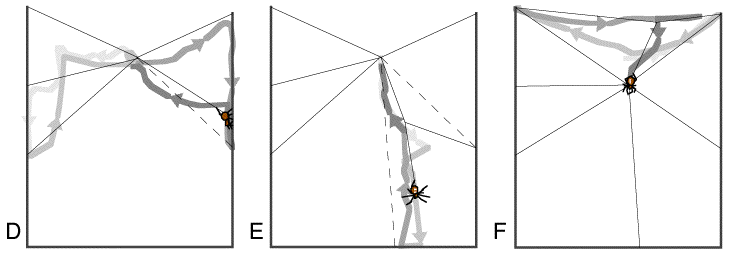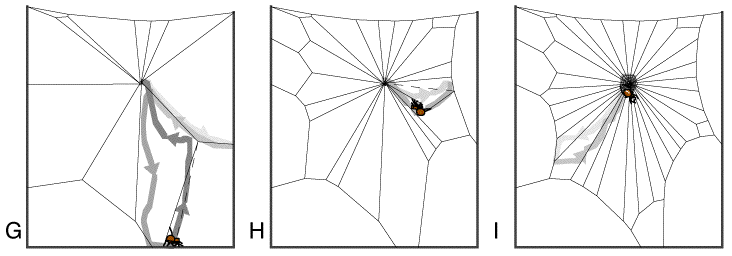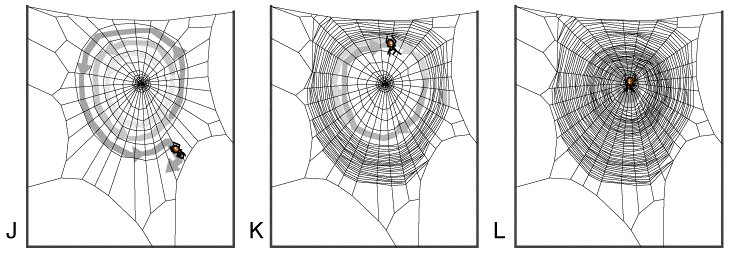Web building in Araneus diadematusThis page depicts the outline of an exemplary orb-web construction of Araneus diadematus in the laboratory. The pictures are based on recorded moves of the spider, with the threads reconstructed from those moves. You can also view this web construction as a Quicktime movie. In each picture, the moves of the spider are indicated with grey arrows (light grey = earlier moves; dark grey = later moves). The plain lines show the position of the threads when the 'snapshot' was taken; the dashed lines show the position of the threads when the spider had completed the moves shown in the picture (only where the position shown of the spider differs from the final one). Remember that the spider always leaves a dragline. In A for instance, it attached the dragline at the top of the right hand stick and walked around the bottom of the supporting structure, always trailing this dragline behind, when it had reached about two thirds of the height of the left hand stick it tightened and attached that dragline thus establishing a first thread across the open space. This is a slightly simplified account of a web construction selected for its simplicity; early stages (i.e. the ones represented in A-E) are highly variable and usually more complicated than the ones shown here (cf. Zschokke 1996), the later stages are always quite predictable.
As a first step, the spider bridges the open space between the two sticks. In the this example built in the laboratory (where there is no wind) this is achieved by attaching the dragline at the top of a stick and then walking the detour along the bottom of the supporting structure (A). Outside, bridging a gap is usually achieved by letting a thread float with the wind, and to then walk across the gap along this thread. When the spider has reached the other side, it climbs up, often only partly, to a point where it tightens and attaches the dragline to use it to cross back to the top of the other stick. The spider then usually tries to move as high up as possible; this may be achieved by replacing the original thread or by adding another one (B). During these early steps of web construction, the spider may pause at any time, be it for a few minutes, be it for several hours.
The spider now establishes the so-called proto-web, a star-shaped structure where several threads (the proto-radii) fastened to the supporting structure come together in a single point, the proto-hub (C-E). The spider constructs proto-radii by attaching the dragline at the proto-hub, walking out along an existing proto-radius and then walking down (D) or letting itself drop down on a thread (E) onto another part of the supporting structure (or web). A new thread is then pulled in between the supporting structure and the proto-hub by attaching the dragline and using it to walk back to the hub. When the spider has established this proto-web (usually with 3-7 proto-radii) it will proceed by building the first frame thread at the top of the future web (also called bridge thread), followed by moving the proto-hub into its final position, turning it into the hub. At the same time the first proper radius (always between bridge thread and hub) is constructed (F).
The next phase in the web building is the construction of the frame and the radii. Primary frame threads (i.e. those attached to anchor threads) and secondary frame threads (i.e. those attached to other frame threads) are built using the basic pattern shown in (G). The spider walks out along an existing radius where it attaches a thread. Dragging this thread behind, it walks back towards the hub and then along the next lower radius where it attaches that thread. It then continues along this newly laid thread back to the upper radius and back to the hub. When the spider builds a simple (secondary) radius, it walks out along an existing radius to the frame, then downward (always!) a bit along the frame where it attaches the dragline. The spider then goes back to the hub, reeling up the new dragline and simultaneously producing the definitive radius (H). The remains of the first dragline can be seen in a web under construction as fluffy white balls of silk in the hub of the web. The order of the construction of the radii follows certain patterns; the spider always puts in the new radius immediately below an existing one; never above and never with a large gap where it would later on add another radius. Additionally, it adds the radii in an order apparently to balance the forces in the hub. When the spider builds the radii it keeps circling the hub to find a gap to place the next radius. This circling then continues after the insertion of the last radius, thus forming the hub structure (I).
The circling of the hub changes without interruption into the construction of the so-called auxiliary (or temporary) spiral. This spiral is widely meshed and serves later as scaffolding and guiding structure for the construction of the sticky (or capture) spiral (Zschokke 1993). When the spider has finished the auxiliary spiral (J) it rests for about one minute. It is thought that this rest is required to switch silk production from the tough, non-sticky silk (which the spider has used for all parts of the web so far) to the sticky, much more elastic silk used for the sticky spiral. After this short break, the spider turns around and starts with the construction of the sticky spiral. During the construction of the sticky spiral - especially along the outer edge of the web - the spider quite often turns around. This results in so called U-turns (also named reverses or switch-backs) in the sticky spiral. It seems that this is done to fill the available space optimally. As the spider advances to the centre of the web, it removes the auxiliary spiral (K). When the spider has finished the sticky spiral, it bites out and eats the centre of the hub (together with the remains from the construction of the radii, see above) and replaces it with a few threads. The spider then remains motionless in the centre of the web and waits for prey to fly into it (L). The spider usually replaces the web every night or every other night. When it stays at the same place it reuses large parts of the anchor and frame threads, but it replaces all radii and the sticky spiral. The old web is ingested and recycled into new silk. The time it takes the spider to get started with web construction varies enormously, but once it really gets going (in this example it was in frame D), it takes the spider about one hour to complete the web. Text and the pictures are adapted from (Zschokke 1996). |
Page compiled and © by Samuel Zschokke (last modified 15-Mar-2009)



